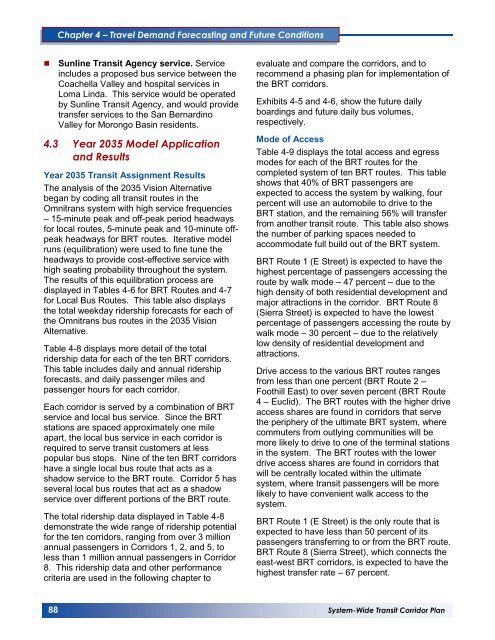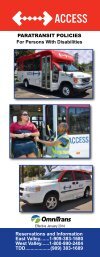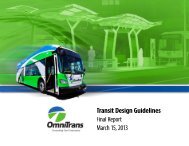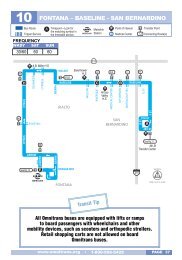New! System-Wide Transit Corridor Plan for the San ... - Omnitrans
New! System-Wide Transit Corridor Plan for the San ... - Omnitrans
New! System-Wide Transit Corridor Plan for the San ... - Omnitrans
Create successful ePaper yourself
Turn your PDF publications into a flip-book with our unique Google optimized e-Paper software.
Chapter 4 – Travel Demand Forecasting and Future Conditions<br />
• Sunline <strong>Transit</strong> Agency service. Service<br />
includes a proposed bus service between <strong>the</strong><br />
Coachella Valley and hospital services in<br />
Loma Linda. This service would be operated<br />
by Sunline <strong>Transit</strong> Agency, and would provide<br />
transfer services to <strong>the</strong> <strong>San</strong> Bernardino<br />
Valley <strong>for</strong> Morongo Basin residents.<br />
4.3 Year 2035 Model Application<br />
and Results<br />
Year 2035 <strong>Transit</strong> Assignment Results<br />
The analysis of <strong>the</strong> 2035 Vision Alternative<br />
began by coding all transit routes in <strong>the</strong><br />
<strong>Omnitrans</strong> system with high service frequencies<br />
– 15-minute peak and off-peak period headways<br />
<strong>for</strong> local routes, 5-minute peak and 10-minute offpeak<br />
headways <strong>for</strong> BRT routes. Iterative model<br />
runs (equilibration) were used to fine tune <strong>the</strong><br />
headways to provide cost-effective service with<br />
high seating probability throughout <strong>the</strong> system.<br />
The results of this equilibration process are<br />
displayed in Tables 4-6 <strong>for</strong> BRT Routes and 4-7<br />
<strong>for</strong> Local Bus Routes. This table also displays<br />
<strong>the</strong> total weekday ridership <strong>for</strong>ecasts <strong>for</strong> each of<br />
<strong>the</strong> <strong>Omnitrans</strong> bus routes in <strong>the</strong> 2035 Vision<br />
Alternative.<br />
Table 4-8 displays more detail of <strong>the</strong> total<br />
ridership data <strong>for</strong> each of <strong>the</strong> ten BRT corridors.<br />
This table includes daily and annual ridership<br />
<strong>for</strong>ecasts, and daily passenger miles and<br />
passenger hours <strong>for</strong> each corridor.<br />
Each corridor is served by a combination of BRT<br />
service and local bus service. Since <strong>the</strong> BRT<br />
stations are spaced approximately one mile<br />
apart, <strong>the</strong> local bus service in each corridor is<br />
required to serve transit customers at less<br />
popular bus stops. Nine of <strong>the</strong> ten BRT corridors<br />
have a single local bus route that acts as a<br />
shadow service to <strong>the</strong> BRT route. <strong>Corridor</strong> 5 has<br />
several local bus routes that act as a shadow<br />
service over different portions of <strong>the</strong> BRT route.<br />
The total ridership data displayed in Table 4-8<br />
demonstrate <strong>the</strong> wide range of ridership potential<br />
<strong>for</strong> <strong>the</strong> ten corridors, ranging from over 3 million<br />
annual passengers in <strong>Corridor</strong>s 1, 2, and 5, to<br />
less than 1 million annual passengers in <strong>Corridor</strong><br />
8. This ridership data and o<strong>the</strong>r per<strong>for</strong>mance<br />
criteria are used in <strong>the</strong> following chapter to<br />
evaluate and compare <strong>the</strong> corridors, and to<br />
recommend a phasing plan <strong>for</strong> implementation of<br />
<strong>the</strong> BRT corridors.<br />
Exhibits 4-5 and 4-6, show <strong>the</strong> future daily<br />
boardings and future daily bus volumes,<br />
respectively.<br />
Mode of Access<br />
Table 4-9 displays <strong>the</strong> total access and egress<br />
modes <strong>for</strong> each of <strong>the</strong> BRT routes <strong>for</strong> <strong>the</strong><br />
completed system of ten BRT routes. This table<br />
shows that 40% of BRT passengers are<br />
expected to access <strong>the</strong> system by walking, four<br />
percent will use an automobile to drive to <strong>the</strong><br />
BRT station, and <strong>the</strong> remaining 56% will transfer<br />
from ano<strong>the</strong>r transit route. This table also shows<br />
<strong>the</strong> number of parking spaces needed to<br />
accommodate full build out of <strong>the</strong> BRT system.<br />
BRT Route 1 (E Street) is expected to have <strong>the</strong><br />
highest percentage of passengers accessing <strong>the</strong><br />
route by walk mode – 47 percent – due to <strong>the</strong><br />
high density of both residential development and<br />
major attractions in <strong>the</strong> corridor. BRT Route 8<br />
(Sierra Street) is expected to have <strong>the</strong> lowest<br />
percentage of passengers accessing <strong>the</strong> route by<br />
walk mode – 30 percent – due to <strong>the</strong> relatively<br />
low density of residential development and<br />
attractions.<br />
Drive access to <strong>the</strong> various BRT routes ranges<br />
from less than one percent (BRT Route 2 –<br />
Foothill East) to over seven percent (BRT Route<br />
4 – Euclid). The BRT routes with <strong>the</strong> higher drive<br />
access shares are found in corridors that serve<br />
<strong>the</strong> periphery of <strong>the</strong> ultimate BRT system, where<br />
commuters from outlying communities will be<br />
more likely to drive to one of <strong>the</strong> terminal stations<br />
in <strong>the</strong> system. The BRT routes with <strong>the</strong> lower<br />
drive access shares are found in corridors that<br />
will be centrally located within <strong>the</strong> ultimate<br />
system, where transit passengers will be more<br />
likely to have convenient walk access to <strong>the</strong><br />
system.<br />
BRT Route 1 (E Street) is <strong>the</strong> only route that is<br />
expected to have less than 50 percent of its<br />
passengers transferring to or from <strong>the</strong> BRT route.<br />
BRT Route 8 (Sierra Street), which connects <strong>the</strong><br />
east-west BRT corridors, is expected to have <strong>the</strong><br />
highest transfer rate – 67 percent.<br />
88 <strong>System</strong>-<strong>Wide</strong> <strong>Transit</strong> <strong>Corridor</strong> <strong>Plan</strong><br />
132














